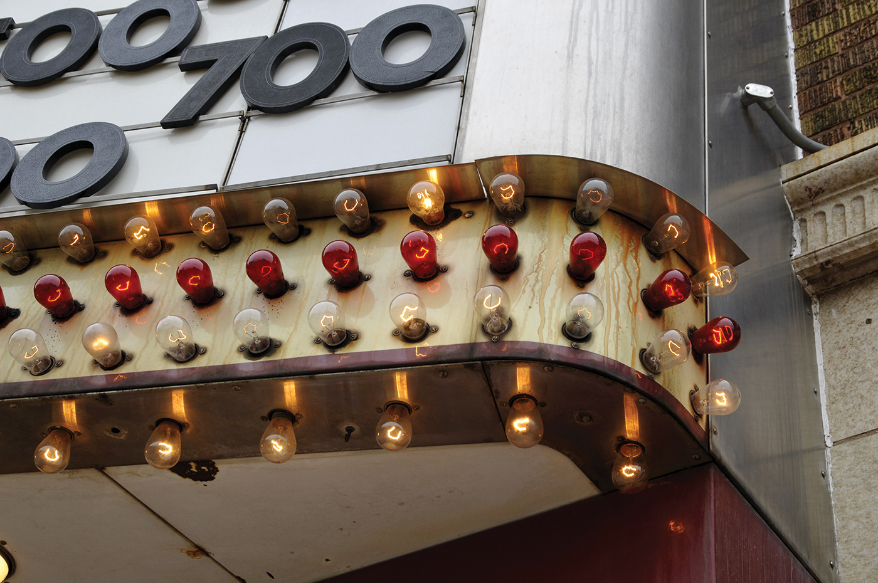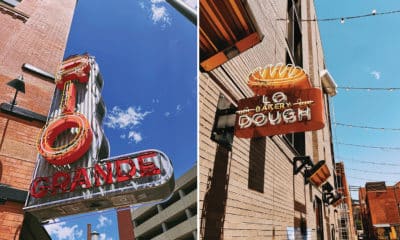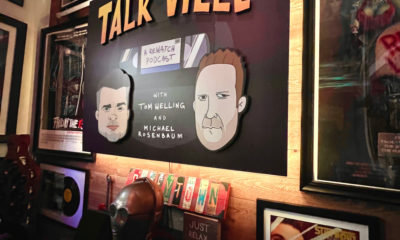LIFE IS ALL FUN and games until it’s not, right? I wake up each day grateful for water and the air I breathe, but put those elements together and we get moisture … Then I get a call informing me that the decorative, ceramic, yellow S14 light bulbs on a sign I made a few years ago aren’t working. Yikes!
I found some rust (if the bulb’s base is brass, the corrosion will appear green with dark brown) and debris around the bulbs and in the sockets after conducting an on-site inspection of the sign. The light bulbs had obviously corroded and they were no longer making a hot-contact connection in the light socket. Such contaminants build up in electronic components and cause performance to suffer. This buildup leads to overheating and premature failure. In my case, only the top section of the sign was affected, due to its exposure to rain and night mist.
Well, the damage was done but it is (mostly) salvageable and better yet, preventable! First things first, make sure the sign is off before doing any work. Don’t say I didn’t tell you so.
Ideally, you do want to remove all lightbulbs even if all of them aren’t corroded. You may experience some bulbs being stuck — another indication of weather damage. Cleaning the rust and dirt off the sockets and bulbs is rather simple but does require time and patience, considering most marquee-type signs have over 40 bulbs.
In this case, I used the good ol’ recipe of a white vinegar and baking soda mix, carefully applied with a soft toothbrush (preferably not your own) around the dirty areas. Depending on the level of damage, you may have to do this repeatedly. Next I damped a microfiber towel in warm water to remove the now-loosened rust, dirt and baking soda residue off the sockets. Another option is to find an electronics cleaner that is hydrocarbon and alcohol-based in case you don’t want to take the DIY route. Either way, get them as clean as possible and focus on the hot contact. You also have to wipe off corrosion on the caps of the light bulbs if they have been compromised.
Wait! Don’t go; we’re not done yet. Here’s the fun part: dielectric grease! How I wish I knew about it sooner. I used CRC’s Technician Grade Dielectric Grease which I was able to find at my local hardware store, though there are many brands in the saturated market. I chose the 3.3-oz. product mainly because it comes in a user-friendly, resealable tube with a nozzle that shoots out just the right amount of grease onto your latex-gloved finger. Apply a dab of dielectric grease and smear around the cap of the lightbulb and/or around the socket. Designed for adverse weather conditions, this grease seals, protects, lubricates and insulates the electrical components. Plus it promotes improvement in electrical performance by reducing arcing and voltage drop.
Advertisement
My hope is that your sockets aren’t damaged to the point of needing full replacement. Thankfully, my sign was back to life and those bulbs were chasing one another happily after the treatment. I know I mentioned prevention: Apply dielectric grease before the sign leaves the shop. Before the sign gets any moisture or dirt and water. Before you go get another cup of coffee. Another measure I’ve learned in addition to applying dielectric grease is adding rubber rings to the bulbs or clear silicone to essentially keep water or other contaminants from entering the sockets. Use your judgment though and stay grateful. For water, air, lights — and grease!


 Tip Sheet1 week ago
Tip Sheet1 week ago
 Photo Gallery3 days ago
Photo Gallery3 days ago
 Ask Signs of the Times5 days ago
Ask Signs of the Times5 days ago
 Real Deal2 weeks ago
Real Deal2 weeks ago
 Benchmarks1 week ago
Benchmarks1 week ago
 Photo Gallery10 hours ago
Photo Gallery10 hours ago
 Women in Signs2 weeks ago
Women in Signs2 weeks ago
 Paula Fargo9 hours ago
Paula Fargo9 hours ago












